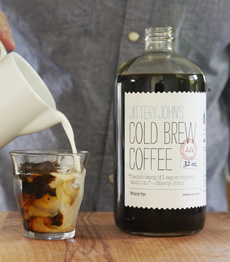TIP OF THE DAY: Make Cold Brew Coffee With A French Press
|
The average American drinks 2.1 cups of coffee a day. Collectively, Americans drink 4,630 cups of coffee each second. And September 29th is National Coffee Day. Cold brew coffee, which has been around quite a while (we’ve had a Toddy cold brew system for 20+ years), has finally hit the mainstream. Coffee drinkers find it has superior flavor; and in the summer, iced coffee is as easy as adding cold water to cold-brew concentrate from the fridge. (Here are some well-reviewed brands). Companies from Folgers to Blue Bottle sell cold-brew coffee. You can buy large bottles of concentrate; you can buy grab-and-go 16-ounce bottles. Yet, if you have a French press, you can make trendy cold brew coffee without purchasing a special cold brew system or a bottle of ready-brewed. The French press recipe is below. But first: A French press is a coffee-brewing device consisting of a pot with a removable plunger made of fine mesh. Coarse-ground coffee is added to the pot, followed by boiling water. The plunger device is placed on top. The coffee grounds float in the water. When the coffee is ready to be poured, the plunger is employed. As it is pushed down, the grounds are pushed to the bottom. It does not use electricity; although you likely need it to heat the water. If you have a French press, there’s no need to buy a cold brew system, or pricey bottles of cold brew coffee at retail. Today, you can find coffee presses in stainless steel, in a stainless holder with a glass beaker (photo #1), and in plastic. French presses are made in sizes from 1-2 cups to 10 cups or more. There are travel mug versions, of course: We use this coffee press “mug” from Bodum. French press or coffee press is the name in English; although in In New Zealand, Australia and South Africa, the apparatus is known as a coffee plunger. In France it is called cafetière à piston; in Italy it is a caffettiera a stantuffo. You can use a French press to brew loose tea as well, but don’t use a press that is used to brew coffee. Even after washing, microscopic bits of coffee oil can cling to the glass or metal, imparting an unwelcome undertaste to the tea. |

[1] The classic design of the modern French press (this one is from Bonjour). [2] One of the artisan cold-brews sold at retail (photo courtesy Jittery John’s). |
|
|
With both coffee or tea, be sure to pour it soon after brewing. Letting the grounds or tea leaves sit under the brewed beverage creates a bitter brew, not a better brew. Conceived In 1852 The first known design for a plunge-type brewer was patented in 1852 by two French designers, Mayer and Delforge. You can see their design at PerfectlyGroundCoffee.com. Per Brooklyn Roasting it was ahead of its time; manufacturing was not precise enough to snugly fit the filter within pot of the design. Others tried their hand, but the first iteration of brewer that we know today was patented by Italian designers Attilio Calimani and Giulio Moneta in 1929. They employed a rubber seal around the edge of the filter. The design evolved, with improved the function of the rubber seal. The design we know today was patented by a Swiss designer, Faliero Bondanini, in 1958. It was manufactured in France and called a chambord. With a compact design and no required electrical outlet, it became a very popular brewing method. These instructions are proportions for an 8-cup French press. Remember that the “standard” cup size used by manufacturers was set long before coffee mugs and modern insulated travel mug containers were in use. So if you use a large mug, you’ll get 4 mugs worth from an 8-cup press, or three 16-ounce travel mugs. Use only coarse-ground coffee. Smaller grains will slip through the mesh filter and produce unacceptable coffee. Ingredients 1. PLACE the coffee in an 8-cup French press. Add the water. Stir the grinds to integrate with the water. 2. PLACE the French press plunger on top (do not plunge into the water) and place in the fridge for 12 hours. 3. PRESS down on the plunger, which pushes all the grounds to the bottom, underneath the mesh filter. Pour and enjoy cold with ice, or warm in the microwave. |
||

|
COFFEE TRIVIA
We start with an important fact for the many people who want more or less caffeine: There is no association between caffeine levels and flavor (e.g. strong coffee). The major difference comes from amount of coffee used and, most importantly, the brewing technique. Cold brew has the most caffeine, followed by drip coffee and espresso. Take this fun coffee trivia quiz. Here are more fun facts from THE NIBBLE and BeFrugal.com. |
|
|
|
||




